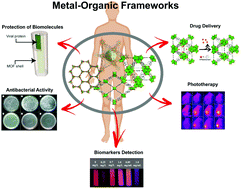Metal–organic frameworks: a future toolbox for biomedicine?
Abstract
The present review focuses on the use of Metal–Organic Frameworks, (MOFs) highlighting the most recent developments in the biological field. This review assesses, in the first instance, the cytotoxicity of MOFs (particularly those used for various biological applications described throughout this review), and shows that for standard MOFs based on metals already present in active molecules of the human body, toxicity is not a significant limitation. Here we underline the MIL-, UiO- and ZIF-series of MOFs which remain until now the most used materials in drug delivery of active pharmaceutical ingredients (APIs), such as antitumourals or retroviral drugs (with high loading and slow release time). Porosity remains undoubtedly the most studied key property of MOFs, that allows the protection of active biomolecules such as enzymes or the development of antimicrobial materials. Emphasis is given on the usage of MOFs for the detection of biomarkers in biological fluids such as urine and blood (detection of cystinuria, identification of penicillin anaphylaxis, urea, bilirubin, biomarkers related to human intoxication, tumoural indicators, among several others), for which a number of simple devices (such as paper strips) were developed. Despite the remarkable and promising results presented in recent years, the literature remains scarce (mostly non-existent) in terms of direct comparison of these novel technologies with the solutions presently available in the market. Action on this side may make the difference in the next years concerning research on MOFs, to see if some of these materials may reach the end-user as new and more efficient treatments or detection approaches.



 Please wait while we load your content...
Please wait while we load your content...